#Mabel Loomis Todd
Explore tagged Tumblr posts
Text

Emily Dickinson, b. December 10, 1830 / 2024
(image: Emily Dickinson, Poems, Edited by two of her friends Mabel Loomis Todd and T. W. Higginson, Roberts Brothers, Boston, MA, 1890)
#graphic design#poetry#book#cover#book cover#emily dickinson#birthday anniversary#mabel loomis todd#t. w. higginson#roberts brothers#1830s#1890s#2020s
51 notes
·
View notes
Text
STAY IN YOUR LAIN
Recent posts have focused on Emily Dickinson’s use of the word “lain” in her poem “I died for Beauty” when the correct word in that instance was “laid."

“For the first editors (of Dickinson’s poetry),” wrote Millicent Todd Bingham in Ancestors Brocades, The Literary Debut of Emily Dickinson, “the perennial uncertainty was: which (of Dickinson’s grammatical errors) are mistakes and which are intentional irregularities with a definite function to perform.”
I’ll cover some of Dickinson’s errors and irregularities tomorrow; however, in the case of “I died for Beauty,” Bingham’s mother Mabel Loomis Todd seemed to prefer that a correction be made. In 1890, she wrote to Thomas Wentworth Higginson, “And do you think it best to leave the ungrammatical use of ‘lain’ instead of ‘laid’ in ‘When one who died for truth was lain’?”
Higginson wrote back, “I have forwarded yr corrections approved except the ‘lain’ which I think had better stay as it is.”
BTW, as an aside, I tried to find statistical information related to the usage of “lain” over time; however, every frequency chart I came across focused on the verb “lie” instead of its past participle “lain.” I did find this, though: “The past participle ‘lain’ of the verb ‘lie’ (meaning to recline) is not as commonly used as other past participles in modern English. While grammatically correct, many speakers and writers opt for alternative phrasing or the past tense form ‘lay’ instead, particularly in casual speech.”
Back to Dickinson:
In his 1938 book This Was A Poet, Amherst College professor George F. Whicher argued that Dickinson’s grammatical errors – including “lain” for “laid” discussed yesterday – were traceable to the fact that she followed the current spoken usage of her time.
I have not read Whicher’s book; however, I did find this information from a 1938 review of his book in the New York Times:
“Against the accusation that Emily Dickinson wrote slovenly and ungrammatically Professor Whicher rises in wrath. Her poems, he states, have never been carefully edited; often there will be more than one reading, and what would be the better reading has not always been the one printed. Moreover, Emily was brought up in the New England vernacular, which went back to grammatical usage not always that of today.”
In her book Ancestors Brocades, The Literary Debut of Emily Dickinson, Millicent Todd Bingham also spoke of Dickinson’s ��grammatical vagaries” and “Emily’s idiosyncrasies” (“such as using ‘of’ for ‘by’: ‘A clover’s simple fame / Remembered of the cow’”).
The review continues:
“Thomas Bailey Aldrich tried to improve certain of her poems, shown him, probably, by Colonel Higginson, but only made them worse. Emily was a law unto herself and a law unto her poetry. Even in her rhymes, which often are no rhymes at all, she must be accepted for what she is, a unique literary being. She has her own special province in the world of poetry; in Professor Whicher's carefully thought-out phrasing, ‘the region of dramatic tension between the mind and experience.’”
#poetry#Emily Dickinson#thomas wentworth higginson#mabel loomis todd#George whicher#millicent todd bingham#lie vs lay#grammar#ancestors brocades
7 notes
·
View notes
Text
Fandoms & Characters on This Blog
CW's Arrowverse
Characters- Eobard Thawne, Harry Wells, H.R. Wells, Sherloque Wells, Nash Wells, Damien Darhk, Leonard Snart, Mick Rory
Batman Multi Media
Characters- Bruce Wayne, Dick Grayson, Jason Todd, Tim Drake, Cassandra Cain, Duke Thomas, Damien Wayne(Platonic unless Adult), Barbra Gordon
Gotham Characters- Jerome Valeska, Jeremiah Valeska, Jervis Tetch
Jokers- Arthur Fleck, Ledger!Joker, DKR Pt.2 Joker, BTAS Joker
Hannibal NBC
Characters- Hannibal Lecter, Will Graham
The Silence of the Lambs
Characters- Hannibal Lecter, Clarice Starling
Supernatural
Characters- Castiel, Chuck Shurley, Gabriel, Lucifer, Michael, Raphael, Amara, Jack Kline(Platonic)
Teenage Mutant Ninja Turtles
2003, 2012, & 2018 Characters- Leonardo, Donatello, Raphael, Michelangelo
The Vampire Diaries & The Originals
Characters- Damon Salvatore, Klaus Mikaelson, Elijah Mikaelson, Rebekah Mikaelson, Freya Mikaelson, Kol Mikaelson, Finn Mikaelson
The Interview With The Vampire
Characters- Daniel Molloy, Armand, Lestat De Lioncourt, Louis De Pointe Du Lac (Platonic unless written with male or gn)
Twilight
Characters- Aro Volturi, Marcus Volturi, Caius Volturi, Carlisle Cullen, Edward Cullen, Rosalie Cullen, Emmett Cullen, Alice Cullen, Jasper Cullen
Sherlock BBC
Characters- Sherlock Holmes, James Moriarty
Criminal Minds
Characters- Spencer Reid, Jason Gideon
House Md
Characters- Gregory House, James Wilson(Platonic)
Slashers
Characters- Beetlejuice, Lydia Deetz, Michael Myers, DBD Michael Myers, Billy Loomis, Stu Macher, Danny Johnson, The Grabber
Diabolik Lovers
Characters- Shu Sakamaki, Reiji Sakamaki, Ayato Sakamaki, Laito Sakamaki, Kanato Sakamaki, Subaru Sakamaki
Rick and Morty
Characters- Rick Sanchez, Prime Rick
Gravity Falls
Characters- Stanford Pines, Stanley Pines, Bill Cipher, Dipper Pines(Platonic), Mabel Pines(Platonic)
Metal Family
Characters- Glam, Victoria, Dee(Platonic), Heavy(Platonic)
Sanders Sides (All Platonic)
Characters- Logan, Patton, Roman, Virgil, Janus, Remus
Five Nights At Freddy's
Characters- William Afton, Sun, Moon
Marvel
Characters- Doc Ock, Loki, Bucky Barnes, Baron Zemo, Stephen Strange, Sinister Strange, Supreme Strange, Jake Lockley, Marc Spector, Steven Grant, Charles Xavier, Erik Lehnsherr
Doctor Who
Characters- Tenth Doctor, Eleventh Doctor, Twelfth Doctor, Thirteenth Doctor, Fifteenth Doctor, Delgado!Master, Ainley!Master, Simm!Master, Missy/Gomez!Master, Dhawan!Master
#marvel#fnaf#sanders sides#metal family#gravity falls#arrowverse#batman#hannibal nbc#supernatural#tmnt#the originals#twilight#amc iwtv#diabolik lovers#slashers#house md#criminal minds#sherlock bbc#rick and morty#doctor who
10 notes
·
View notes
Text










The Emily DickinZINE : vol. 3 / no. 3.5
I HATE writing annotations in books that I own, so the habit has become to copy phrases, or make note of something special, or comment upon it in a separate little book.
THIS is a recent notebook on re-reading LETTERS OF EMILY DICKINSON, the first edition of 1894, edited by Mabel Loomis Todd.
80 pages, bound with ribbon, embroidered cover
11 notes
·
View notes
Text





FOUND : various clippings
in a copy of Letters of Emily Dickinson, edited by Mabel Loomis Todd, The World Publishing Company, first printing January 1951
6 notes
·
View notes
Text
Poems Poets toy with ideas and play with words and pour the latentfeelings in their hearts in the poems, with fertile imagination. They paint a picture without color and the strokes of brush. Poets are choosy about the words, and take care to see that they convey the intended meanings. In those words the literal meaning, origins and connotations are equally important to derive the total effect, and they are like the alternative beats of the same heart. Diction is poet’s special way to convey the internal fire, the spontaneous overflow of powerful feelings that take the form of art and aesthetics to create the magical effects. The poems being analyzed in this essay are “For Malcolm, a Year After,” by Etheridge Knight and “Because I Could Not Stop for Death,” by Emily Dickinson. "For Malcolm, A Year After,” (Hill, n. p.) is a popular ballad. He wrote this poem as an inmate at the Indiana State Prison. This poem is a “tribute to Malcolm X.”(Hill, n. p.) He asked the fellow “prisoners about Malcolm X the year after Malcolm’s assassination,” (Hill, n. p.) what was that date. None was able to give the correct answer. An agitated Knight reverted to his barracks and wrote the poem. His angry mood is reflected through the poem. “Because I could not stop for Death,” is a lyric poem by Emily Dickinson, published posthumously in 1890. Compiled and edited by her friends Mabel Loomis Todd and Thomas Wentworth Higginson. The poem was titled, “The Chariot,” initially. It relates to Death. The poet elucidates Death as a noble individual, who rides the carriage with her body to take it to the grave. In effect, the poet personifies immortality. The main points discussed in the poems are two faces of death. One merging with the eternity, another is the tragic termination of the life-force. Emily Dickinson examines Death from a friendly encounter and from the philosophical perspective of immortality, whereas Etheridge Knight reacts to Death with controlled vehemence for the violent end of an ideologue and challenges the causes leading to that tragedy. The literary element discussed in this paper is diction. Poetic diction is the distinctive language employed by the poets that is not common day slang. Diction involves archaism, rhyme, neologisms and figures of speech. Poetic diction is much different from daily speech and they succeed in demanding the attention of the readers. Words are used intelligently by the poets to convey feelings, action and attitudinal issues. The choice of one word to challenge the other is diction. Dickinson does not turn away from mortality and the she challenges Death as if it is a friendly encounter, --Oh, Death, come on, I sport with you! Thus the choice of diction is critical in the delivery of the message of the poem. “For Malcolm, A Year After,” is a political support statement for a black leader who commanded the respect of the poet. He intelligently and deliberately “manipulates metrical tensions and rhyme schemes”,(Hill, n. p.) as he constructs the statement for the slain nationalist leader. He launches the attack with a stinging statement, but holds it well to check the “self-destructive emotional explosion.”(Hill, n. p.) “Control the burst of angry words Or they might boil and break the dam” (L, 3-4) “Rhyme connects the form in the “iamb” (L, 2) and the anger in “dam.” (L, 4) He writes in the language of the white man, but from the bottom of his heart, he rejects it. He detaches himself away from the rhyme in “mad” (L, 5) “The second stanza emphasizes that while Knight uses the Euro-American culture's form, he uses it to advance the political cause of Black Nationalism. Inverting the traditional conceit of the poem living eternally despite the death of the man, Knight writes that his poem, an artifact of the oppressive culture, will die, but its message, the message of Malcolm X, will live.” (Hill, n. p.)The next lines of the poem are implicit parody of “the standard couplet form” (Hill, n. p.) to reiterate the revolutionary emotions that marked “the life and death of Malcolm X.”(Hill, n. p.) “Death might come singing sweet like C Or knocking like the old folk say, The moon and stars may pass away, But not the anger of that day.” (L, 12-15) The poet conveys a significant piece of information about the history of Blacks in America, in a few well-chosen words. “Because I could not Stop for Death,” deserves a perfect 10 and it is flawless viewed from any angle. Its movement and development are smooth, unlike that of Knight, which is full of twists, turns and bumps. Each image explains something profound and beautiful, and linked to the central idea. The first image creates an expectation about the next image being introduced. The flow is lucid, and a garland of flowers has been created as if, out of the theme of death, and the one controlling death is benevolent, as if he is taking a lady for the pleasure drive. The terror of death is duty bound, performs his functions to fulfill the objective of Immortality. He does his job without malice and with love and marches toward the final goal without making any comment about it. Physical disintegration is the challenge to immortality of the soul. Dickinson’s diction has two important components. She uses words of Latin or Greek origin, and in sharp context, introduces the Saxon element, as if they are the alternative beats of the same heart. She correctly gauges the metaphysical relations of these two languages and uses them appropriately to maximum advantage. Read the full article
0 notes
Text
Be prepared to defend an economic or sexual decision
- RENEWABLE MABEL LOOMIS TODD
- SHOESTRING MABEL LOOMIS TODD
- DISPARATE MABEL LOOMIS TODD
0 notes
Text
FINAL RESULT: The majority of voters liked this poem, but haven’t read it before. 😊
“Crumbling is not an instant’s Act” is a poem by Emily Dickinson, published sometime between 1890—1896. From Wikipedia: “Emily Elizabeth Dickinson (December 10, 1830 – May 15, 1886) was an American poet. Little-known during her life, she has since been regarded as one of the most important figures in American poetry. Dickinson was born in Amherst, Massachusetts, into a prominent family with strong ties to its community. After studying at the Amherst Academy for seven years in her youth, she briefly attended the Mount Holyoke Female Seminary before returning to her family's home in Amherst. Evidence suggests that Dickinson lived much of her life in isolation.
Although Dickinson was a prolific writer, her only publications during her lifetime were one letter and 10 of her nearly 1,800 poems. The poems published then were usually edited significantly to fit conventional poetic rules. Her poems were unique for her era; they contain short lines, typically lack titles, and often use slant rhyme as well as unconventional capitalization and punctuation. Many of her poems deal with themes of death and immortality (two recurring topics in letters to her friends), aesthetics, society, nature, and spirituality.
Although Dickinson's acquaintances were most likely aware of her writing, it was not until after she died in 1886—when Lavinia, Dickinson's younger sister, discovered her cache of poems—that her work became public. Her first published collection of poetry was made in 1890 by her personal acquaintances Thomas Wentworth Higginson and Mabel Loomis Todd, though they heavily edited the content. A complete collection of her poetry first became available in 1955 when scholar Thomas H. Johnson published The Poems of Emily Dickinson. In 1998, The New York Times reported on a study in which infrared technology revealed that certain poems of Dickinson's had been deliberately censored to exclude the name "Susan". At least eleven of Dickinson's poems were dedicated to her sister-in-law Susan Huntington Gilbert Dickinson, and all the dedications were later obliterated, presumably by Todd. This censorship serves to obscure the nature of Emily and Susan's relationship, which many scholars have interpreted as romantic.”
Do you know this poem?

Please reblog the polls, but KEEP IT SPOILER-FREE to make people read the poem with an open mind 💖📚 Title and author will be revealed after the poll's conclusion.
39 notes
·
View notes
Text

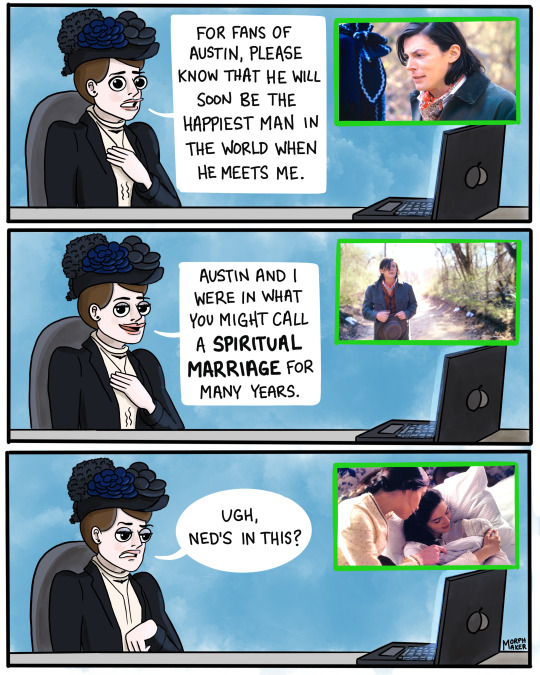
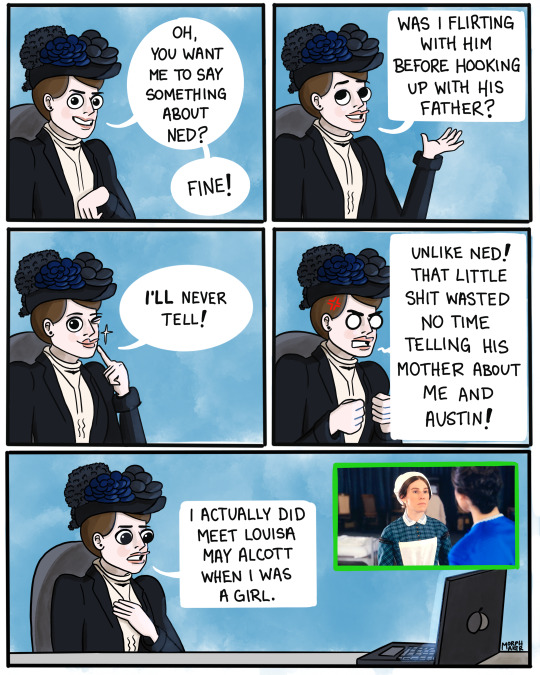
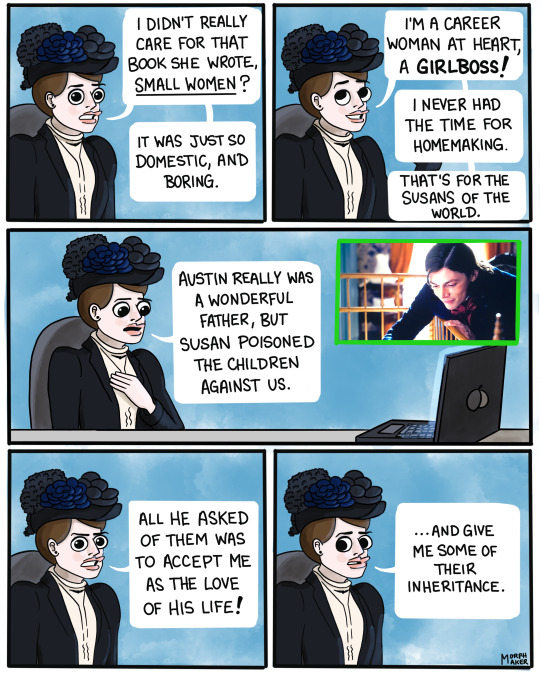
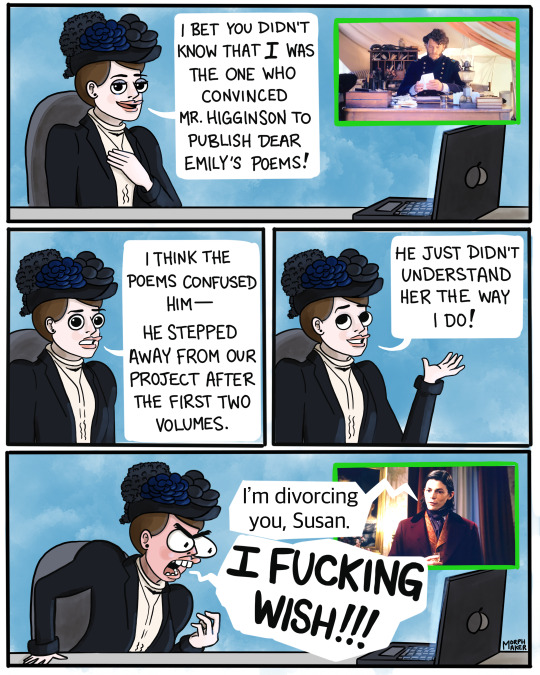
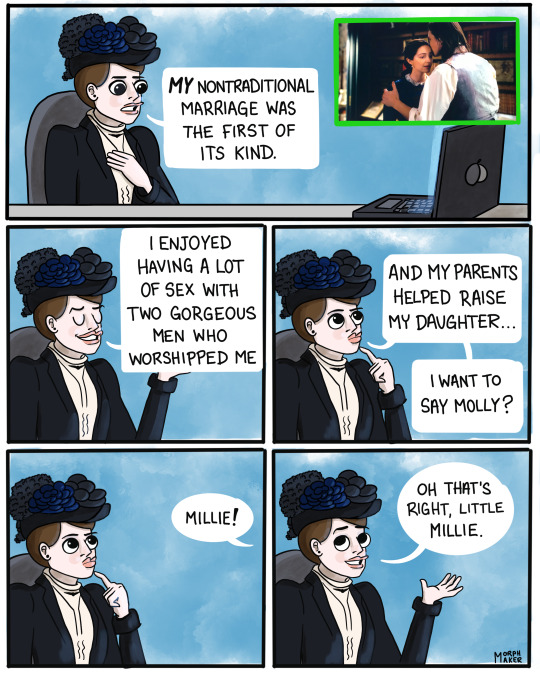
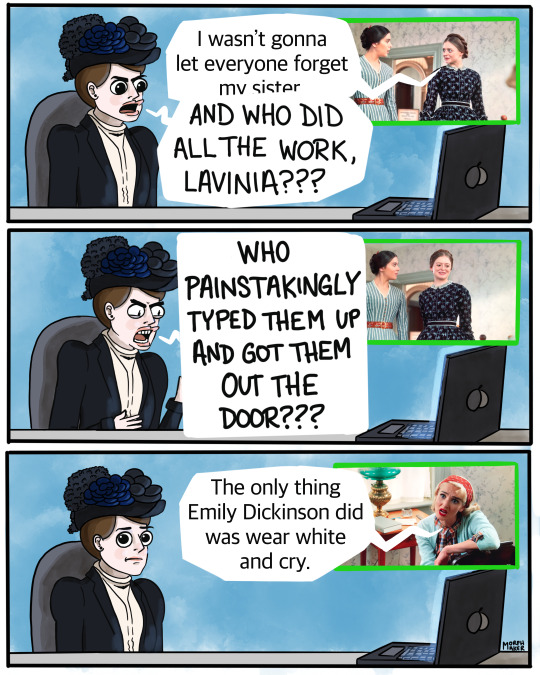
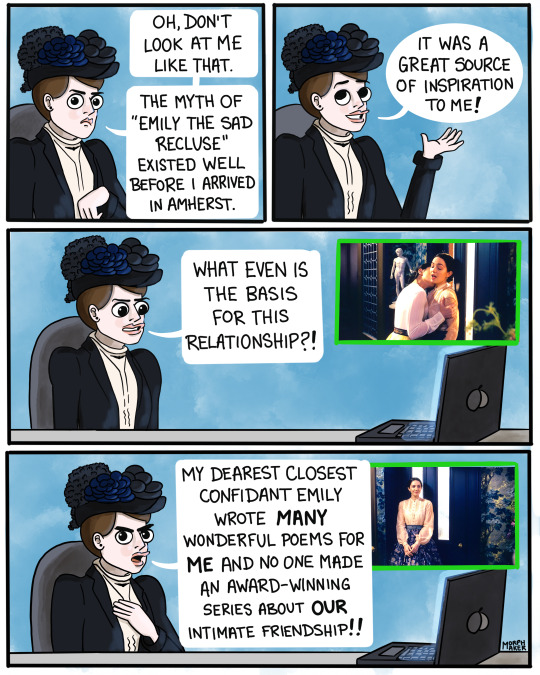
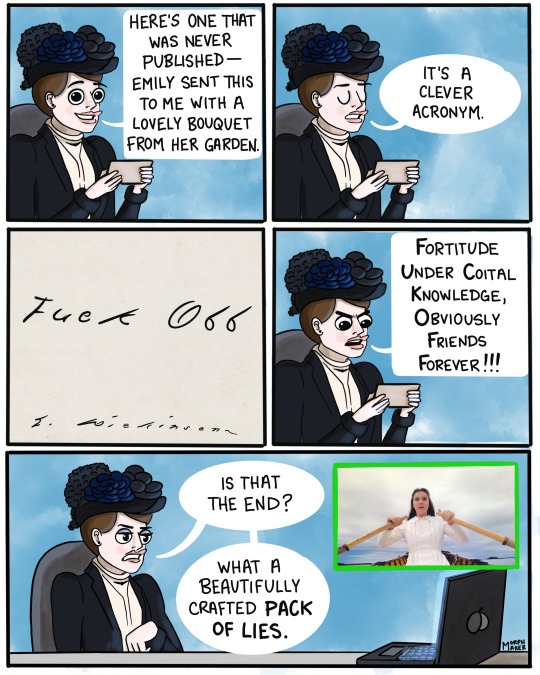
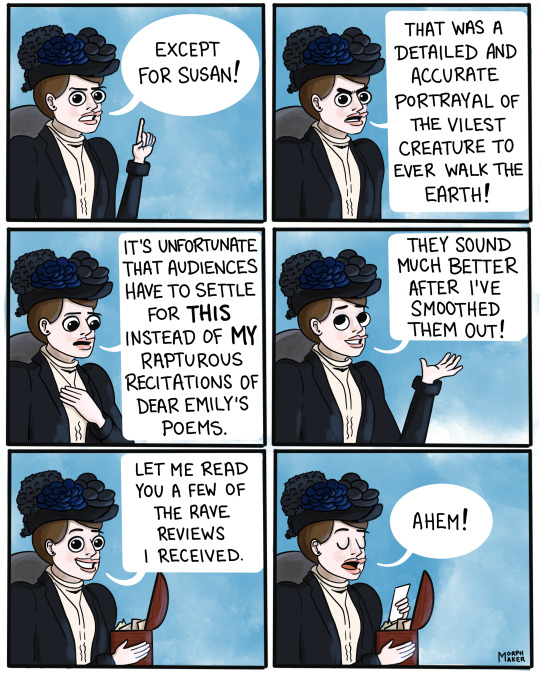
"A beautifully crafted pack of lies." – Mabel Loomis Todd Reacts to the Final Season of Dickinson
Previously: Mabel Loomis Todd Reacts to Two Seasons of Dickinson
Sources: Lives Like Loaded Guns by Lyndall Gordon, Austin and Mabel: The Amherst Affair and Love Letters of Austin Dickinson and Mabel Loomis Todd by Polly Longsworth, White Heat: The Friendship of Emily Dickinson and Thomas Wentworth Higginson by Brenda Wineapple, emilydickinson.org, Open Me Carefully by Martha Nell Smith and Ellen Louise Hart, Wild Nights with Emily movie, my own imagination
#dickinson#emily dickinson#lavinia dickinson#susan gilbert#austin dickinson#mabel loomis todd#susan dickinson#jane humphrey#Louisa May Alcott#thomas wentworth higginson#sylvia plath#morphmaker arts
62 notes
·
View notes
Text

Emily Dickinson, It's all I have to bring to-day [ca. 1858], in Poems, Edited by Mabel Loomis Todd, Roberts Brothers, Boston, MA, 1896, Third Series
It's all I have to bring today, This, and my heart beside, This, and my heart, and all the fields, And all the meadows wide – Be sure you count – should I forget Some one the sum could tell – This, and my heart, and all the Bees Which in the Clover dwell.
43 notes
·
View notes
Text
This Was A Poet
Today marks the 139th anniversary of Emily Dickinson’s death. She died on May 15, 1886 at the age of 55. The last letter she wrote to her cousins consisted of just two words, “Called Back” – and those two words are etched into her tombstone.
I wrote about that yesterday, HERE.
Interestingly, Mabel Loomis Todd gave Dickinson’s poem “Just lost when I was saved!” the title “Called Back” when she published it in the “Second Series” of the poet’s “Poems” in 1891.

For information about Dickinson’s death and funeral, check out this page from the Dickinson Museum’s site, HERE.
From that page, “Emily Dickinson was interred in a grave Sue had lined with evergreen boughs, within the family plot enclosed by an iron fence.” Pictures of the family plot are below.

I also found this travelogue (HERE) written by someone who had visited Amherst – including Dickinson’s gravesite – in 2002, and it makes mention of the plaque on the iron fence dedicated to the “poetess”: “‘The Dickinson Kinsfolk’ (members of the extended family, as no direct descendants of Squire Dickinson survived beyond 1943) enclosed the plot with an iron fence and affixed the plaque seen at right in 1954.”
Seriously? Was the term “poetess” being bandied about in the 1950s? I s’pose so!
I looked up the usage of the word and – to be honest – I’m not so sure I’m picking up what Google’s putting down here! LOL. Here’s what I found – and it suggests that the usage of “poetess” from the 1950s to 2019 declined only slightly? I mean seriously, who uses the word “poetess" these days?

And just FYI: Dickinson was writing poetry at that time of peak usage for “poetess” in the chart above. However, she wrote eight poems that included the word “poet,” and not a single one with the word “poetess” – and in the eight poems, she used both feminine and masculine pronouns in regards to the “poet." Just an observation.
In closing, here are the opening stanzas to Dickinson’s “This was a Poet” – and surely, the lines describe Dickinson’s gift:
This was a Poet – It is That Distills amazing sense From Ordinary Meanings – And Attar so immense From the familiar species That perished by the Door – We wonder it was not Ourselves Arrested it – before –

INFO FROM THE EMILY DICKINSON MUSEUM:
Today, we'll be remembering Emily Dickinson on the 139th anniversary of her death.
Here are a few ways you can honor the poet:
Share your favorite poem and tag the Museum on socials.
Plan your visit to the place she called home.
Make a supporting gift in honor of her poetic legacy.
In a remarkable obituary for The Springfield Republican, Susan Dickinson described her sister-in-law’s unique creative gift in these words: “A Damascus blade gleaming and glancing in the sun was her wit. Her swift poetic rapture was like the long glistening note of a bird one hears in the June woods at high noon, but can never see.”
Special thanks to all who supported the Museum by making a donation at our Poetry Walk. A daisy has been placed at Dickinson's grave for each of you and your loved ones.
3 notes
·
View notes
Text
Talking to men fr feels like ure defending a phd thesis like why is every convo with them some kind of debate where theyre trying to act like they know more than you
#some guy mansplaining emily dickinson to me when obv i know alot about her or i wouldnt even be posting abt her#to begin with if ure acting like the og poems edited by mabel loomis todd is worth more than modern collections i alr know u dk shit#like. . sure the heavily edited works r better than her poetry as she wrote and preserved them. and to say my books are worthless paperbacks#LIKE excuse you?? sry if im buying books to read them not to have shiny fancy hardbacks to put behind a glass case
3 notes
·
View notes
Text
“Emily kept her little reserves, and bared her soul but seldom, even in intimate correspondence. Petty trivialities had no part in her constitution, and she came to despise them more and more,—so much, indeed, that with her increasing shyness, she gradually gave up all journeys, and finally retired completely from even the simple life of a New England college town.” -Mabel Loomis Todd on Emily Dickinson, in her introduction to Letters of Emily Dickinson, published 1894 // “She came to me with two day lilies which she put in a sort of childlike way into my hand & said "These are my introduction" in a soft frightened breathless childlike voice — & added under her breath Forgive me if I am frightened; I never see strangers & hardly know what I say —” -Thomas Wentworth Higginson recalling his meeting with Emily Dickinson, in a letter to his wife Mary Elizabeth Channing dated 16th August, 1870 // “She was much too enigmatical a being for me to solve in an hour's interview, and an instinct told me that the slightest attempt at direct cross-examination would make her withdraw into her shell; I could only sit still and watch, as one does in the woods; I must name my bird without a gun, as recommended by Emerson.” -Thomas Wentworth Higginson, recounting the meeting with Emily Dickinson twenty years later, in the Atlantic Monthly LXVIII(October 1891)
#Emily Dickinson#Mabel Loomis Todd#Thomas Wentworth Higginson#Mary Elizabeth Channing#lit#letters#Letters of Emily Dickinson
25 notes
·
View notes
Photo
I really hope one day more people will know Emily Dickinson as more than a recluse. Even if she was introverted that doesn't always equal shy. She was witty, had friends, and a romance with a woman. The shy sad hermit take on her sometimes turns people away from her amazing poetry, and that's a real shame. Also, screw Mabel. Thankfully, technology she couldn't have dreamed of foiled her plan to literally erase Sue from Emily's story.






The ending of Wild Nights with Emily (2018) dir. Madeleine Olnek
8K notes
·
View notes
Text
mabel loomis todd hate blog idc that shes dead
0 notes
Quote
A vast, palpable presence seems overwhelming the world. The blue sky changes to gray or dull purple, speedily becoming more dusky, and a death-like trance seizes upon everything earthly.
Mabel Loomis Todd’s poetic and scientifically illuminating 19th-century guide to viewing a total solar eclipse.
#Mabel Loomis Todd#Emily Dickinson#total solar eclipse#eclipse#science and technology#science#space#lit#history and literature
92 notes
·
View notes